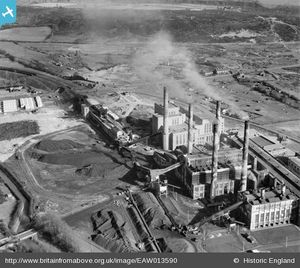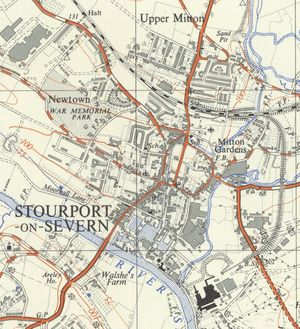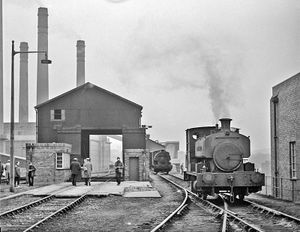Stourport Power Station

Stourport Power Station was built by the Shropshire, Worcestershire and Staffordshire Electric Power Co. Construction started in 1923, and it commenced supplying electricity on 1 April 1926. J. T. H. Legge was engineer.[1] It was opened in June 1927 by the Prime Minister, and MP for Bewdley, Stanley Baldwin. Unusually the power station did not have the customary cooling towers, drawing cooling water directly from the adjacent River Severn and River Stour.
After the second World War construction of Stourport 'B' station took place for the British Electricity Authority, the original station becoming Stourport 'A'.[1]
Contents
Association with the Severn Valley Railway
Coal was initially delivered to the power station via the River Severn or the Staffordshire & Worcestershire Canal (which can be seen passing under the SVR at Falling Sands Viaduct). The additional sidings and canal basin built at Stourport Station in 1885 allowed coal to be brought there by rail, then transshipped to boats for the final leg of its journey to the power station. The majority of the coal came via the canal by barge direct from collieries in the Cannock Coalfield.
Electric railway
The coal was unloaded from the barges at the 'Furthermost Basin' by two electric grabs, and transferred to the power station via hoppers along a short length of aerial ropeway.[2]
Coal was brought in by a 2ft 6in gauge railway. At the company's private wharf two jib-cranes (or derricks) were utilised to unload the barges, and they discharged into hoppers feeding conveyor belts. These took the coal above Severn Road and discharged into more hoppers situated above the 2ft 6in gauge railway tracks, upon which were waiting rows of small coal trucks.
To operate the traffic the power station obtained, in 1925, two four-wheel battery-electric locomotives from English Electric (Works Nos 688 and 689). They were painted in a dark green livery and were numbered 1 and 2. The lettering 'English Electric Co Ltd/Dick Kerr system' was inscribed on their controllers. They were small, low, locomotives, with outside frames almost down to track level, and unusually they were fitted with wooden block buffers. They were fitted with a very cramped end-cab and were powered by rechargeable heavy duty storage batteries. A fitting shop, with two tracks, was provided for stabling and servicing the locos, and to provide battery recharging facilities. No. 1 was scrapped in 1984.[3]
Their basic duties were twofold. They were principally used to collect coal tubs from the wharf hopper, and trundle them past the coal stocking areas to the boiler house. Normally eight tubs at a time were moved, each weighing about half a ton, although they reputedly pulled over a dozen tubs at busy times, particularly during the Second World War. The coal was offloaded, passed through hoppers and a weighing machine, and thence ran by conveyor belt to the boiler house bunkers. Any coal not immediately required was diverted to another conveyor belt and stockpiled at the storage grounds. Their second duty was ash disposal. A large quantity of waste ash was produced when coal was burned in the boilers, and this was deposited into storage bunkers outside the boiler house. From there it was dropped into purchasers' lorries, or into narrow gauge wagons. The English Electric locos then transferred the tubs to the tip, or to the wharf for loading the ash into purchasers' water-borne transport.
Standard gauge branch
Authorisation for construction of the power station granted in 1918 included a branch railway of 7.3 furlongs along an embankment, joining the Severn Valley branch 25 yards east of the bridge over the Staffordshire & Worcestershire Canal. This was not built at the time and the powers lapsed. They were renewed in 1938 and the branch line constructed so that coal could be brought in directly by rail. From Stourport the branch successively crossed Mill Road, the River Stour, Hartlebury Road and Worcester Road on plate girder bridges. Main line locomotives were not allowed beyond this last bridge.[4]
The branch opened in early 1940 and by 1949 all but 5% of the coal arrived by this route. A portion of the coal for Stourport Power Station came from the collieries served by the Severn Valley line, with approximately 30% of the output of Alveley Colliery being sent to the power station. The majority of the coal continued to come from Cannock Chase, with such coal arriving at Hartlebury from Stourbridge, often behind a Midland engine. A shunting locomotive was stationed at Hartlebury to shuttle coal wagons between there and Stourbridge.[5] A former NCB employee's recollections of coal workings can be found in Tales from the Severn Valley.
After closure of a nearby sand quarry, the siding which had served it was used to hold trains of coal wagons waiting to enter the power station.
A second power station on the site was opened on 26 September 1950; this became known as Stourport B with the earlier station becoming Stourport A.
Locomotives
A second locomotive, WG Bagnall 0-4-0ST works number 2665 "General Wade Hayes", arrived in 1942. These two locomotives were the mainstay of shunting operations for some years, although by January 1958 a third locomotive had arrived, Peckett 0-4-0ST 1893/1936, which had begun life at Ironbridge power station as Ironbridge No 2. Bagnall 2665 was scrapped in 1968, and by 1975 the other locomotives were retained as spare, their work having been assumed by diesel shunters. Peckett 1893 was also preserved and is now at the Coleford Railway Museum in the Forest of Dean.[3]
Greenwood Batley 2000/1945 ‘Greenbat’ was used by the Central Electricity Generating Board for shunting wagons at Stourport Power Station until the conversion to merry-go-round system of coal delivery rendered the locomotive redundant. It can be found at Ribble Steam Railway and Museum[7].
Closure
By the 1970s the power station was in decline, with Stourport A being closed in 1976.[3] Coal continued to be delivered to the power station by rail via Hartlebury, but an increasing proportion was delivered by road towards the end of the 1970s, until coal trains ceased in March 1979 and road haulage took over completely.[8][9] The line itself was finally taken out of use on 12 January 1981.[10] Stourport B finally closed in 1984 and has since been demolished, with the area now mainly being a housing estate. The bridge over Worcester Road was demolished on 4 February 1986.[4]
Gallery
See also
References
- ↑ 1.0 1.1 Stourport Electric Power Station on Grace's Guide
- ↑ Staffordshire and Worcestershire Canal (1974), J. Ian Longford, p. 180.
- ↑ 3.0 3.1 3.2 Adrian Booth article
- ↑ 4.0 4.1 Marshall (1989) p. 88.
- ↑ Recollection of former NCB employee
- ↑ Rocks by Rail (Retrieved 13 June 2016)
- ↑ Greenwood Batley 2000/1945 ‘Greenbat’, Ribble Steam Railway and Museum (Retrieved 25 November 2020)
- ↑ Mitchell & Smith (2007)
- ↑ Stourport Past Facebook Page, retrieved 14/06/2016
- ↑ Vanns p. 94.
'The Archivist' Facebook page, 25 November 2020 (Retrieved 25 November 2020) from which details of the narrow gauge railway are taken.










